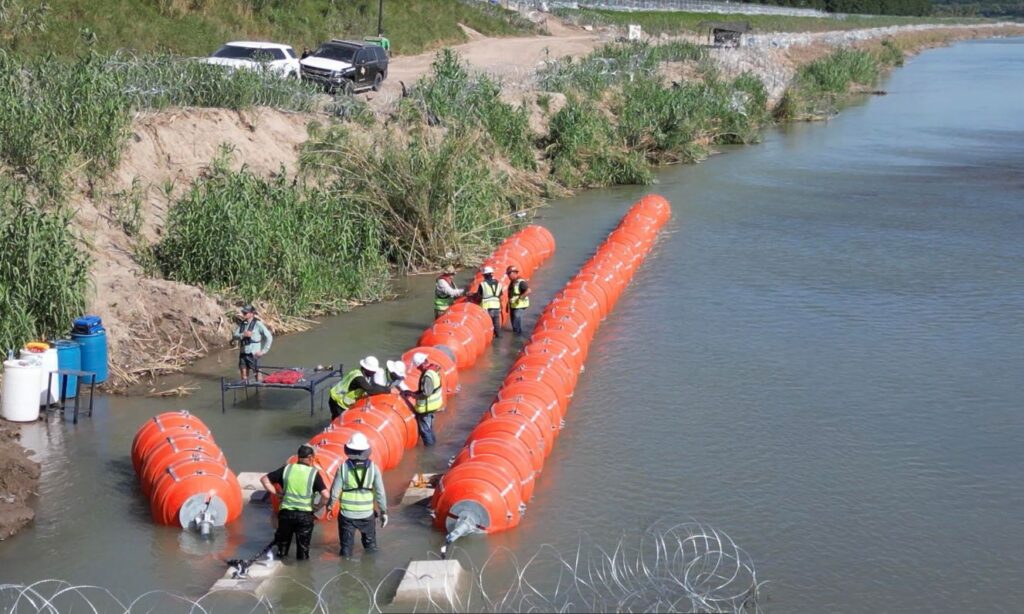
By Todd Bensman as published August 9, 2023 by the New York Post
AUSTIN, Texas – If I’ve learned anything studying and reporting about illegal immigration for 15 years, it’s this:
Champions of illegal immigration who don’t like a given new border-control measure will claim they never work. But when the activists really know – deep in their guts – that the idea will actually work too well, they’ll hard-charge political, propaganda and court campaigns to kill it. Think Donald Trump’s border wall or his Remain in Mexico policy, which illegal immigration advocates always asserted would never work but who, upon witnessing them work, launched a World War III of political advocacy and court action that killed both (and other impactful policies besides).

Most recent case in point: Republican Texas Gov. Greg Abbott’s new floating marine barrier.
Last month, Texas spent $1 million to lay the first thousand feet of the bright orange floating buoys, nets weighted to the river floor, on a high-traffic stretch of Rio Grande in Eagle Pass with plans to keep extending it for miles as necessary.
It will never work, illegal immigration proponents like Mexico’s president immediately yelled. Like Trump’s border wall, it’s a folly, they claimed.
Of course, they know that’s not true: The wall and water barrier are extremely effective, and that’s why they must stop it.
The first weapon they use is a propaganda campaign. The barrier is genocidal, inhumane and cruel, people like San Antonio Congressman Joaquin Castro are starting to claim, without evidence.
“We view it [the marine barrier] as a chilling reminder of the extreme measures used throughout history by elected leaders against those they do not regard as human beings, seeking only exterminate them, regardless of the means employed,” Rodolfo Rosales of the League of United Latin American Citizens told CBS News in one typical talking point.
With that table set, it was no surprise that mass migration advocates, their liberal US media supporters, and Mexico’s president and foreign ministry seized on a recent occasion when a body was found on the barrier and another one found nearby. Before any inconvenient fact-finding could intervene, the mass illegal-immigration advocacy crowd spun a narrative that Texas’s water wall had killed someone.
“Abbott’s border policies have taken yet another life,” Joaquin Garcia of the La Unión del Pueblo Entero (LUPE), publicly declared without evidence.
It wasn’t true, of course. The Honduran on the barrier drowned well upstream and floated to the barrier, Texas Department of Public Safety Director Steve McCraw told the Houston Chronicle. The second body was found three miles upstream.
“The Mexican government is flat-out wrong,” Abbott spokesman Andrew Mahaleris said in a prepared statement August 5. No matter; the initial narrative survives everywhere on the Internet, repeated without shame.
Next, predictable court litigation began. These included a Biden administration lawsuit and proposed US Fish and Wildlife regulations claiming the barrier threatens endangered riverbed mussels, and violates international requirements for federal government permission.
One private lawsuit by a kayaking company claims the barrier ruins the recreational experience and, as though political feeling more than kayak navigation motivated this one, that the barrier is “a hateful policy that intends to create the impression that Mexicans, immigrants, and Mexican Americans…are dangerous.”
This is all desperation. Because barrier opponents know it will serve to limit illegal immigration.
The US Customs and Border Protection tested the very water wall that Abbott has installed and found that it defeated almost all comers, former CBP Commissioner Mark Morgan told me.
“The R&D was extensive” during the Trump era, Morgan said. Then President Biden entered office and killed the project.
Did the testing show it stopped immigrants, I asked?
“Of course it did,” Morgan said. “We had it ready to go. That’s why the governor of Texas was able to implement it so quickly.”
After the 2000 terror attack against the USS Cole with an explosives-laden raft in a Yemen port, for instance, the US Navy began deploying them against “water-born intrusions” at ports around the world. The island city-state of Singapore installed water walls a decade ago to stop illegal immigration at hotspots along its coastline to slow an ongoing mass-migration crisis by sea.
Today, water barriers are part of a system that cordons 70% of that island nation’s coastline. By 2020, illegal immigration had fallen to pre-crisis levels in Singapore.
Papers published long before Texas executed on its barrier show that versions of such structures, albeit mainly in salt water, have for decades worked well blocking and deterring divers or small watercraft on sabotage and terrorism missions. They’re also used to strong deterrent effect around natural gas terminals, tankers, refineries, desalinization plants and nuclear power facilities, as evidenced by the proliferations of companies around the world that began making them.
The success of water barriers protecting Singapore and sensitive military assets around the world should help explain why pro-illegal immigration advocates ginned up a campaign like the one against Texas to defeat a floating barrier that Greece proposed in 2020 to block a crowded route to some of its Aegean Sea islands.
Human rights groups and their liberal political allies knew it would work. So they collectively pounced with familiar propaganda, political and legal campaigns.
The barrier works. That’s why they’re going through these extreme paces.
Is the pattern of campaign about the Texas barrier starting to sound familiar?
Get used to it. More is probably on the way. A senior Texas law enforcement official points out a trigger for motivating rage about the first thousand feet of barrier:
“No one’s getting near it. No one’s going over it. No one’s going under it,” the official said. “I’d like to have another two miles of it.”